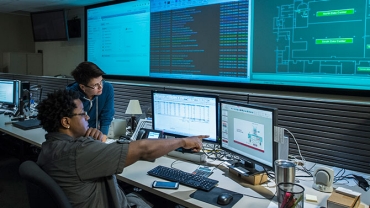
Making the most of 5G: why partnerships will be key for the transition to new mobile services
Our collaboration with the FT and World Economic Forum explores how technological shifts are transforming industry, business and society.
Imagine slipping on a smartphone-connected headset to explore holiday options and taking a seamless virtual-reality tour of a beach resort in Phuket – all courtesy of an online travel agent, who has paid for the cost of transmitting the data.
As telecommunications operators start to roll out 5G, the next generation of mobile communications technology, data speeds 100 times faster than today’s standard are poised to revolutionise the types of products and services wireless networks can deliver – as well as who ends up footing the bill.
But research suggests that the operators building this 5G world will have to form far deeper and wider-ranging partnerships than in the past if they hope to survive in an era increasingly dominated by technological disruption.
“The transition to 5G requires a significant departure from the business-to-business and business-to-consumer models that telecom companies have relied on until now,” says Rolf Meakin of Strategy&, PwC’s strategy-consulting arm. “They will have to collaborate much more.”
Partnerships will be needed to help pay for the rollout itself. According to IDC, a market-intelligence group, telecoms operators will spend up to $57bn during the next three years as they update infrastructure and invest in spectrum to build 5G networks.
Those elevated costs are needed to serve an increasingly digitalised global population: IDC estimates that more than five billion consumers already interact with data every day – a figure that will rise to 6bn, or 75 per cent of the world’s population, by 2025. By that year, every connected person is likely to have at least one data interaction every 18 seconds, it says.
Yet recent PwC research indicates that only one-third of internet users today would be willing to pay more to upgrade to 5G – and only 31 per cent of mobile users would accept higher charges in return for the significantly faster service.
To compensate, Meakin argues that operators will have to start replacing their traditional B2B and B2C revenue models with one that he calls “B2B2X”. “Services will need to be brought to market by a neater system of partnerships where X can be a consumer, business, machine, object, robot or public sector,” he explains.
“Operators’ efforts to monetise the technology face some challenges,” says Meakin. “The consumer pull that encouraged the rollout of 4G mobile services is likely to be much weaker with 5G.”
One example of B2B2X is third party-led partnership that could involve a managed service provider running a production line on behalf of an industrial brand using a network of robots and sensors enabled with a private 5G network, and data analytics provided by a telecoms operator.
Another could be a telecoms operator-led partnership in which the operator bundles wearable devices, home sensors, health diagnostics and telemedicine services with a 5G network plan, and sells the package to its customers.
Using dedicated “slices” of network performance, brands and advertisers could pay operators for delivering virtual reality-based advertising and promotions to consumers, and TV journalists could directly broadcast from events and incidents using 5G - completely changing outside broadcast operations.
There is no doubt that 5G technology has the potential to create and support products and services that do not exist today. In addition to the prospect of overwhelming speed compared with 4G, 5G offers about 1,000 times the bandwidth or capacity, making it a vastly more efficient network.
Perhaps most significantly, 5G promises ultra-low latency, which is the time it takes for data to travel from one point to another. The resulting ability to transmit data in near real time creates huge opportunity for developing new use cases involving remote, precision-control of complex machines and processes and will enable the full transformative potential of other technologies such as AI, robotics, drones, the Internet of Things (IoT) and augmented and virtual reality.
These developments have the potential to create the next generation of customer experiences and productivity enhancements which could spur economic growth right up to the 2030s.
Karime Kuri Tiscareno, project lead for IoT, robotics and smart cities at the World Economic Forum, argues that the advent of 5G is unlike previous generation changes in cellular technology because it will fundamentally change the way that education, healthcare and other core services are provided around the world.
Heightened connectivity will enable remote, around-the-clock medical assistance, real-time control of remote surgery and even the delivery of medical supplies – via connected drones – to communities inhabiting the remotest places on Earth.
But to ensure that this step change in digital technology benefits entire populations rather than select groups within them, network owners, governments and regulators need to form deeper partnerships than in the past, she says. “Because 5G can unlock so many promises, governments have to play a huge role – and a much bigger one than they have played in previous rollouts,” Kuri Tiscareno says.
The challenge is clear. “The message we keep crafting is that 5G will introduce new efficiencies and new possibilities in terms of innovation but at the same time there is a huge risk that it could deepen the digital divide,” she adds.
“How do we make sure that through public-private partnerships networks are rolled out in an inclusive way and provide a level playing field? Finding a solution is just as important as getting the business model right.”
Note: This content was produced by the advertising department of the Financial Times, in collaboration with Strategy&, part of the PwC network.







